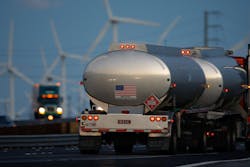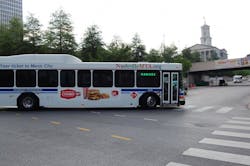While surface transportation systems are becoming more “attractive” as targets for terrorists – especially due to ever tighter airline security measures – Mineta Transportation Institute (MTI) experts believe the threat to trucking remains relatively low overall.
However, Bruce Butterworth, a Mineta research associate and former director of aviation security operations at the Federal Aviation Administration (FAA), told Fleet Owner that doesn’t mean threat risks don’t exist – especially where tanker fleets are concerned.
“While we primarily focus on the surface transportation of the public by rail and by bus, it is probably fair to say that for attackers seeking high body counts with a minimum of complications – such as the jihadists we are most concerned about – your average commercial truck does not present a target more valuable than a mass transit system of a large city that carries large number of people and upon which people rely, or buses where people also rely on them,” he explained.
Of course, Butterworth noted that deranged people and “lone loons” can attack any time and anything, and have, so that needs to be taken into account. “Also, patterns can change, and past attack records are no guarantee that the future will remain the same,” he added.
“[But] a key exception to what we say about commercial trucking would be gasoline and, to a lesser degree, propane tankers which carry commodities that could … be used to attack infrastructure and, more importantly, targets such as buildings or even open air events where large numbers of people could be consumed by fire and/or explosive force,” Butterworth pointed out.
Butterworth and Brian Michael Jenkins, director of the MTI’s national transportation safety and security center, also noted in a recent research update that current security measures make airliners “hard targets,” and thus over the years, the number of attempted hijackings and bombings gradually has declined—though the public areas of airports remain vulnerable, they stressed.
Yet in contrast, public surface transportation—trains, metros, subways, and buses—offer terrorists easy access and crowds of people, making them especially attractive to terrorists seeking high body counts; helping explain why terrorist attacks on surface transportation targets have increased worldwide, Butterworth said.
“As for buses, our research shows that buses are attacked outside of North America quite frequently, and with surprising lethality,” he told Fleet Owner. “But these tend to occur in developing countries which rely upon buses and also in developed countries – such as Israel – that also rely on them.”
By contrast, in the U.S., bus transportation generally is not relied upon as much as it is in these countries, which may make it a less valuable target, he said.
“But here again, deranged persons and common criminals are something that should be of concern, and can do significant damage in an enclosed environment using arson – this has happened in China – or knife or a firearm, which has happened here,” Butterworth stressed.
Yet he noted that this does not mean surface transportation management personnel necessarily must have their “hair on fire” when it comes to concerns over terrorism.
In fact, in a recent report, MTI found that while the number of plots against mass transit systems have grown and are very worrying, between 1970 and 2015 there were only 18 serious and criminal attacks in Canada and the U.S. against passenger train and bus targets, of which only six caused any fatalities (a total of 15) with the three with the greatest death tolls caused by “deranged individuals” such as Colin Fergusson’s shooting spree in a Long Island Railroad train car that killed 6 and injured 19 back in 1993.
All told, in Western Europe and North America between 1970 and the end of 2015, only about 11% of terrorist attacks in the world occur in Western Europe, Canada and the U.S. against public transit systems. Since 1970, there have been only 22 attacks in Canada and the U.S. against passenger trains and buses, along with another 31 attacks against freight trains and transportation infrastructure such as roads and tracks, according to MTI’s data, with only four of those attacks causing fatalities.
Still the bad news, though, is that surface transportation targets continue to appear in terrorist plots – indicating that trains and buses are clearly in the terrorists’ playbooks, MTI said.
For example, worldwide, terrorist attacks with 25 or more fatalities on buses, trains and passenger ferries grew from only four between 1975 and 1985 to 39 between 2005 and 2015, the group noted.
About the Author
Sean Kilcarr
Editor in Chief
Sean Kilcarr is a former longtime FleetOwner senior editor who wrote for the publication from 2000 to 2018. He served as editor-in-chief from 2017 to 2018.

